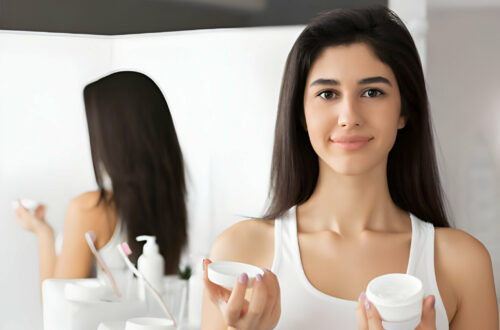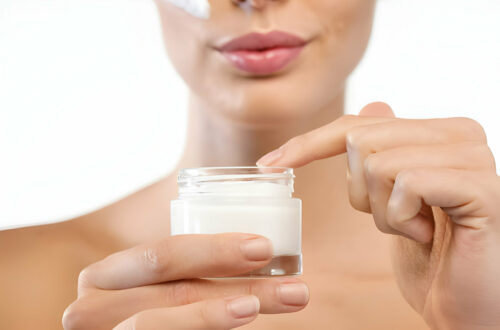Layering your skincare products in the right order can help your skin soak up more of the good stuff, so you see results.
Here’s the simple rule: start with the thinnest products and work your way up to the thicker ones. This way, the lightweight stuff gets absorbed first, and the thicker ones come after. This way, you make sure that your skin can absorb all the good stuff without any blockages. Dr. Mitchel P. Goldman, a certified dermatologist and the founder of Cosmetic Laser Dermatology says thicker products can act like a wall and keep the good ingredients out.
You don’t need a fancy 10-step routine. Understanding how to build a skin care routine is essential. The basic plan is to use a cleanser, moisturizer, and SPF. This way, you keep your skin clean, happy, and safe from the sun. Plus, using fewer products lowers the chances of skin trouble.
But if you want to get fancy and add more products to your routine for specific skin issues, including learning how to hydrate skin, here’s the right order to use them.
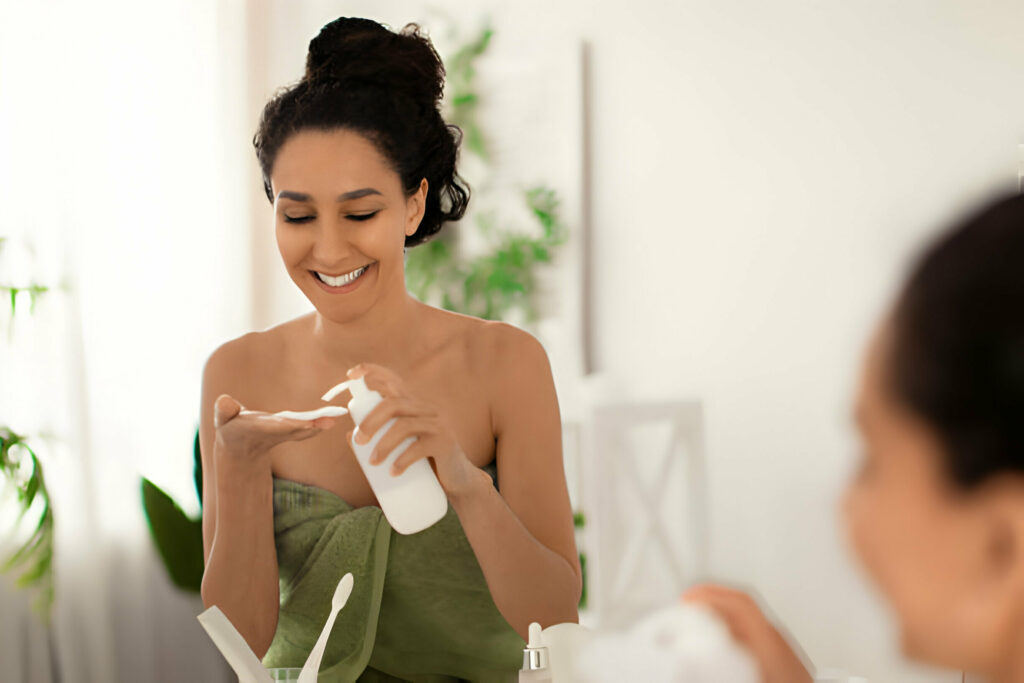
Step 1: Cleanser
The first thing you should do in your skincare routine is wash your face. Cleansing is the starting point. It helps your skin get ready to soak in other products, and it clears away the dirt, oil, and gunk that can build up in and around your pores.
When you pick a cleanser, go for one that’s gentle, doesn’t have alcohol, and isn’t rough on your skin. These cleansers won’t take away too many of the oils your skin needs to stay balanced. However, different skin types might need cleansers with more hydrating or oil-controlling ingredients.
Important ingredients to look for include ceramides, glycerin, hyaluronic acid, or aloe vera if you have dry skin. If you want to soothe your skin without taking away its natural moisture, try niacinamide, green tea extract, or chamomile. Additionally, consider using snail mucin in skin care for its hydrating and healing properties. On the other hand, ingredients like benzoyl peroxide, glycolic acid, salicylic acid, and tea tree oil can help manage excess oil, clear out clogged pores, and reduce acne.
How to use it:
- Wet your face with lukewarm water.
- Gently rub the cleanser into your skin with your fingertips.
- Pat your face dry with a towel.
- Clean your face in the morning and at night, and after sweating a lot.
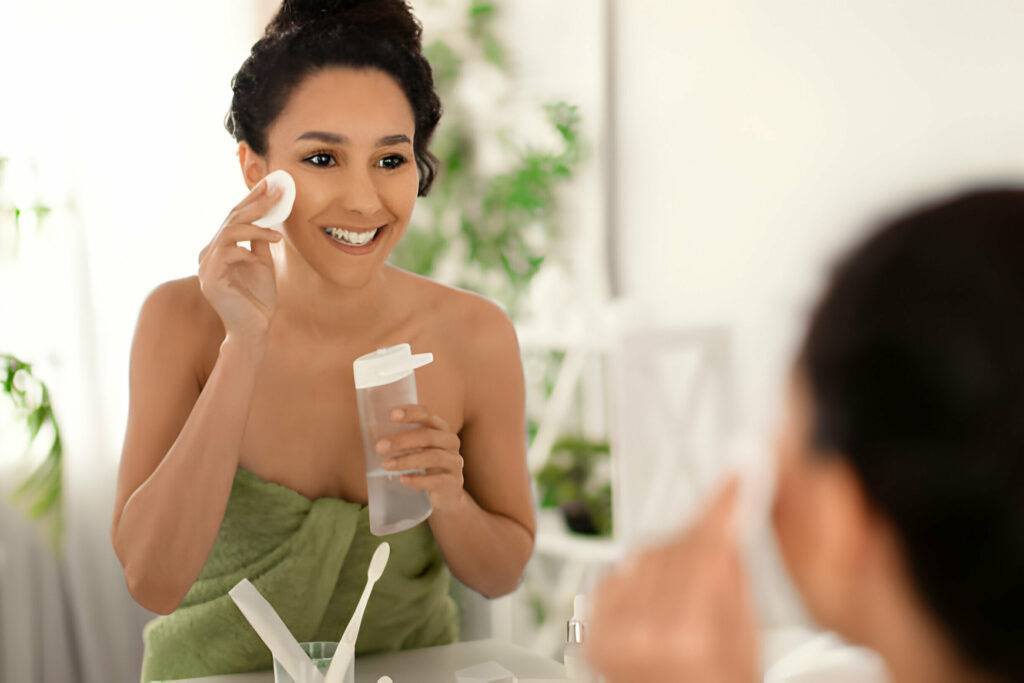
Step 2: Toner
You don’t always need a toner, but it can give your skincare routine an extra boost. Toners can help get rid of any leftover oil and dirt after cleansing, which makes your skin even more ready for other products. They can also hydrate dry skin and help keep the right balance in your skin’s pH, which might prevent acne.
Important ingredients: If you have dry or sensitive skin, go for toners with hydrating stuff like hyaluronic acid or rose water, as suggested by Goldman. For pregnancy safe skin care, ensure the products are free from harmful chemicals. If you have oily or acne-prone skin, look for toners with ingredients that can shrink pores and remove extra oil, like salicylic acid or witch hazel.
How to use it:
- Wet a cotton pad or ball with toner.
- Gently dab the toner onto your face.
Step 3: Spot Treatment
If you want to zap a pimple or fade dark spots, you should use spot treatments right after you cleanse or tone. These products focus on small areas of your skin and have different ingredients depending on what you’re treating. Putting spot treatments on your fresh, prepped skin helps the good stuff in them get deep into your skin.
Important ingredients: For dealing with acne, look for spot treatments with ingredients like benzoyl peroxide and salicylic acid. To fade dark spots, go for spot treatments with hydroquinone or kojic acid. These ingredients are good at taking care of specific issues, says Goldman.
How to use it:
- After cleansing (and toning), put a small amount of spot treatment on the problem area using clean fingers.
- Use these products as needed, but follow the instructions from the product maker about how to use them. If you’re using other serums or treatments after your spot treatment, don’t put them on the same spot where you applied the treatment.

Serums are like speedy superheroes for your skin, and you should use them right after cleansing or toning. They’re products with a lot of special ingredients that can do good things for your skin. Usually, serums are light and watery, so they can get deep into your skin and make it better by adding hydration, brightness, or targeting specific skin problems.
The special ingredients in serums can be things like Vitamin C, niacinamide, stuff that fights aging, and things that hydrate.
Important ingredients: Vitamin C makes your skin bright, softens wrinkles, and fades dark spots. Niacinamide smooths out fine lines, helps with acne, makes pores smaller, controls oil, and brightens your skin. You’ve also got Vitamin E, hyaluronic acid, peptides, ceramides, and glycerin, which keep your skin moist. Alpha hydroxy acids (like glycolic and lactic acid) are good for hydrating and making your skin smoother. Serums with salicylic acid and azelaic acid are good for acne because they clean out pores and reduce swelling.
How to use it:
- Take a bit of serum (usually the amount the maker of the product suggests) and put it on your face with clean fingers.
- Then, gently rub the serum into your face and neck using a light tapping motion.
Mixing Active Ingredients
If you’re using lots of treatments or serums, the order of the special ingredients matters. “Usually, it’s not a good idea to mix retinol with alpha or beta hydroxy acids because it can make your skin dry or irritated,” says Goldman. “Also, mixing vitamin C with niacinamide might make it less effective.”
When you’re not sure how to put these special ingredients together, it’s smart to ask your dermatologist.
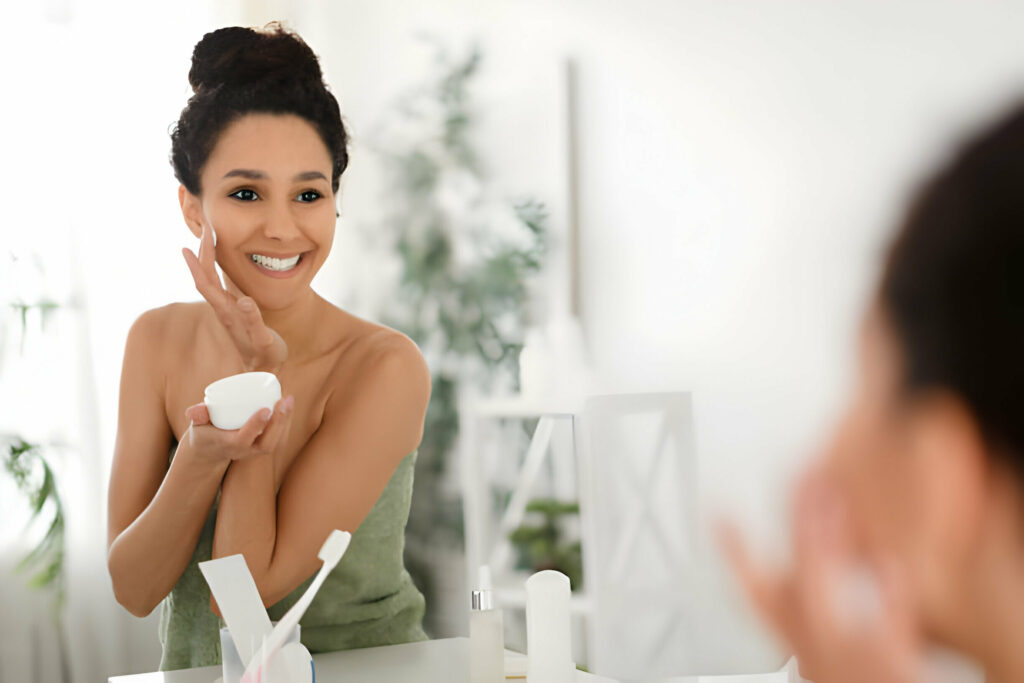
Step 5: Retinol and Other Retinoid Treatments
After you’ve used serums, it’s time for retinol and other retinoid treatments. These are usually thicker and create a sort of barrier on your skin. “When you use retinol cream after the serum, you make sure that the serum’s active stuff has already gone into your skin. This way, the retinol can reach deep into your skin, giving you the most it has to offer,” says Goldman.
Retinol (technically a type of retinoid) and other retinoids come from vitamin A. They help your skin by making it refresh itself more often, boosting collagen production, and making the whole texture better. This helps with fighting aging and acne.
Important ingredients: You can get over-the-counter (OTC) retinol, retinyl palmitate, and retinaldehyde, which are less strong than other retinoids. These are good for people with sensitive skin, just a few wrinkles, and milder issues like acne, uneven skin tone, and dark spots.
For more serious acne and wrinkle problems, dermatologists give prescriptions for retinoid treatments like Differin (adapalene), Retin-A (tretinoin), Tazorac (tazarotene), and Aklief (tazarotene). OTC Differin (adapalene) is also an option and is FDA-approved for acne treatment.
How to use it:
- Start with a small amount, like a pea-sized bit of retinol or retinoid treatment, every other night until your skin gets used to it.
- Only use retinol and retinoids at night because they make your skin sensitive to the sun.
Step 6: Eye Cream
If you’re into using eye cream, put it on after any treatments because it’s a bit thick. It helps soak in better that way. Eye cream isn’t a must-have, but it can give extra moisture to the delicate skin under your eyes. That skin is more likely to get wrinkles and sun damage.
Important ingredients: For daytime eye creams, check for things like peptides, antioxidants (like vitamin C or green tea extract), and SPF to guard against sun damage, as suggested by Goldman. Nighttime eye creams can have things like retinol, niacinamide, or hyaluronic acid to fix and hydrate your skin.
How to use it:
- Lightly tap the eye cream on your under-eye area using your ring finger. Be gentle; don’t pull or rub.
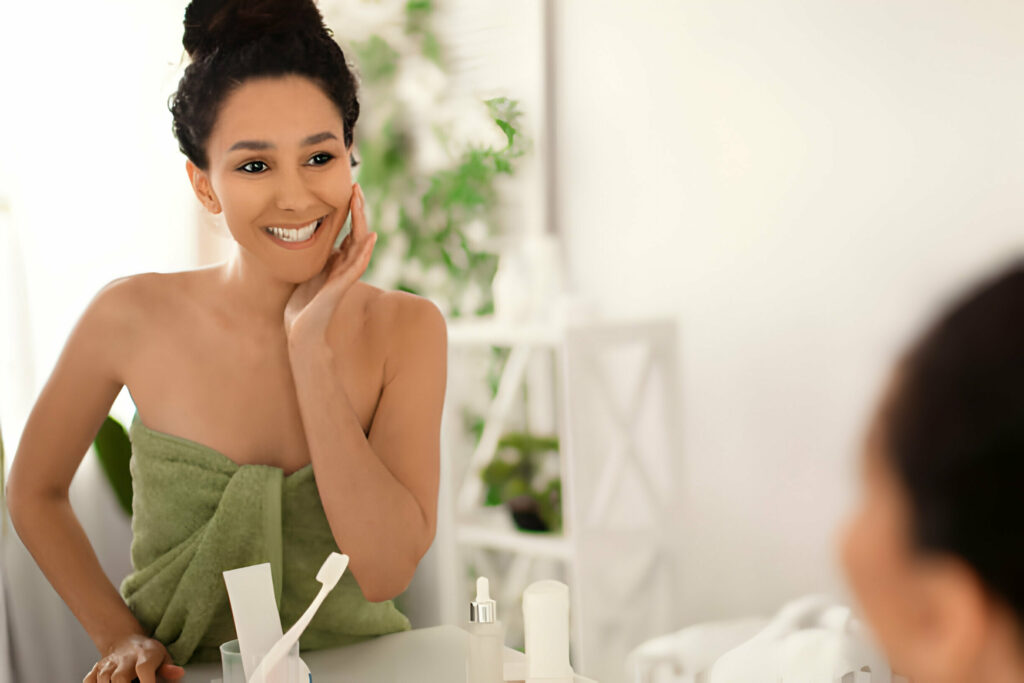
Step 7: Moisturizer
Moisturizers are usually a bit thicker, so use them after lighter serums or treatments. If you’re keeping it simple, just use moisturizer after cleansing. Moisturizers are meant to put water into your skin and fix your skin’s protective layer. But they also create a seal on your skin, which can stop thinner products from getting in all the way.
Important ingredients: If you have dry skin, find moisturizers with things like ceramides, glycerin, or shea butter for really good hydration. For oily or acne-prone skin, go for oil-free, non-cloggy moisturizers with ingredients like hyaluronic acid or lightweight gel stuff.
How to use it:
- Gently massage the moisturizer onto your whole face and neck. Don’t forget the under-eye area if you didn’t use an eye cream.
Step 8: Face Oils
Face oils add more moisture and hydration to your skin. You should use them after your moisturizer. Face oils are usually thicker and heavier than moisturizers. They create a kind of shield that stops the moisturizer from fully getting into your skin, according to Goldman.
Important ingredients: Go for face oils that are rich in fatty acids like argan, coconut, or avocado oil to nourish and hydrate your skin. Chamomile and rosehip oil can help calm irritated skin, while lighter oils like jojoba and grapeseed oil can help control oil production.
How to use it:
- After you moisturize, put a few drops of face oil on your fingers.
- You can also drop the oil right onto your forehead and cheeks.
- Gently rub the oil onto your face and neck.
Step 9: Sunscreen
Sunscreen isn’t only for the beach. You should always put it on last in your morning skincare routine. Using it every day helps shield your skin from ultraviolet (UV) rays, which can cause skin cancer and early signs of aging, like sunspots and wrinkles.
The American Academy of Dermatology says to use sunscreen that has broad-spectrum protection and an SPF of 30 or higher. You can also use makeup and moisturizers with SPF, but they might not give you enough protection if you’re out in the sun for a long time, as noted by Goldman.
How to use it:
- Gently apply sunscreen to your face, neck, chest, and ears.
- You should use about a nickel-sized amount of sunscreen for every square centimeter of skin, which is roughly 2 milligrams.
- Chemical sunscreens take around 15 minutes to soak in, while mineral sunscreens work right away. For both types, remember to put more on every 2 hours.
Why the Order Matters
The reason why the order of your skincare products is important is all about absorption, consistency, and pH, according to Goldman.
Your skin can only soak up so much product, and when you put your skincare on in the wrong order, your skin ends up taking in even fewer active ingredients. Also, when you use thicker products like moisturizers before lighter ones like serums, it stops the active ingredients from getting in.
Putting your skincare in the right order also helps your skin keep its pH balance so your products can do their job properly. “Some products, like chemical exfoliants or things that depend on pH, need the right pH range to work their best,” explains Goldman.
A Quick Recap
Getting the order of your skincare right ensures that your expensive products and much-needed treatments do their job properly. A good rule to follow is to always start with the thinnest products and work your way up to the thicker ones to make sure everything gets absorbed.
At the very least, your skincare routine should include cleansing, moisturizer, and sunscreen. For anti-aging skin care, if you need extra help with things like acne, wrinkles, or other skin issues, you can use spot treatment, serum, and retinol.
If you’re not sure which active ingredients and products are best for your skin type, it’s a good idea to talk to your dermatologist.



